|
Handheld Algiz 10X (updated for 2nd gen version April 2015, updated with spec updates Sep. 2016)
Second generation of the Handheld Group's reasonable, rational 10-inch rugged tablet for those who need Windows out there on the job, wherever that may be
(by Conrad H. Blickenstorfer; Photography by Carol Cotton)
Update September 2016: Handheld upgraded the Algiz 10X from a 1366 x 768 pixel resistive touch screen to a 1920 x 1080 pixel 10-point capacitive multi-touch screen with optional active capacitive pen. Handheld also upgraded the positioning system of Algiz 10X from a u-blox NEO-6T to a u-blox NEO-M8N with concurrent GPS and GLONASS support. The upgraded version uses Windows 10 Enterprise LTSB (64-bit).
Swedish Handheld Group originally announced the Algiz 10X tablet toward the end of 2012 as an addition to the company's lineup of rugged mobile computers for use in markets such as utility, military, logistics, forestry, transportation and field service. To make it clear right upfront: The Algiz 10X didn't aim to be a ruggedized iPad or Android tablet for the field. Instead of apps and capacitive multi-touch, it runs Windows 7 or Windows 8 and all Windows software on a resistive touch screen. So this was not a tablet for pinching and zooming and panning and 99-cent apps. That was not what Handheld had in mind with the Algiz 10X.
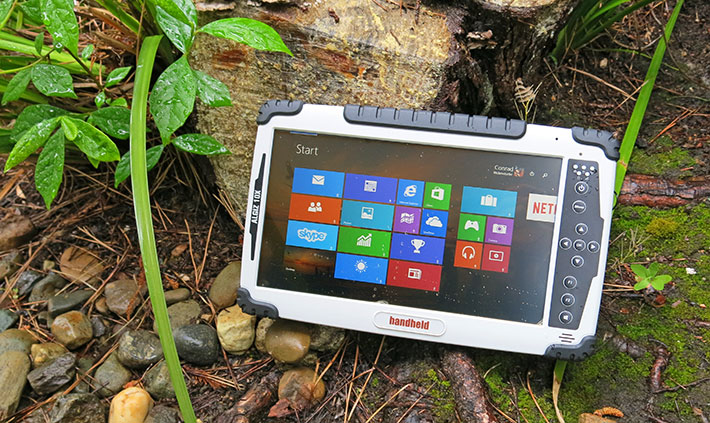
What they did have in mind was providing contemporary technology in a conventional mobile Windows tablet. The Algiz 10X model extended Handheld's tablet lineup—which already included 7-inch and 8.4-inch devices—into the popular 10-inch space. The 10X measures 10.8 x 6.7 x 1.2 inches and weighs 2.9 pounds. That's larger and heavier than consumer market tablets, but the Algiz 10X wasn't designed to be a consumer device; it's for today's mobile workforce that's surveying, building, patrolling or distributing out there in the field where it can get cold and wet and things get dropped or banged around.
Technology, however, advances very quickly these days, and so in February 2015 Handheld released a major performance update to the Algiz 10X. This report is an revised version of our original full review of the tablet, incorporating all the changes implemented in the second gen Algiz 10X..
First impressions of the Algiz 10X
What's differentiating and appealing about the Algiz 10X? For existing customers of Handheld Group tablets, the larger screen is certainly exciting. Not only are there times when you simply do need a larger display for certain tasks, there are also situations where applications do require more pixels than what's available on older SVGA (800 x 600 pixel) and even XGA (1024 x 768 pixel) devices. The Algiz 10X display offers 1,366 x 768 pixels, which means essentially 720p HDTV resolution in a modern 16:9 wide-format display. That's more resolution than all those tens of millions of original iPads and iPad 2s, and plenty enough for demanding GIS applications and anything else that requires a lot of screen real estate.
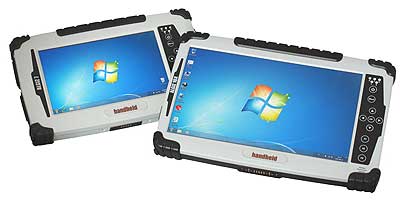 Also of note is the latest version of Handheld's MaxView display technology that uses a combination of optical treatments to make their displays remarkably vibrant and readable under virtually all viewing conditions. Handheld uses a special bonding process to "melt" LCD, anti-glare filter and touchscreen together, minimizing reflections and making the screen stronger. Among the many benefits of the MaxView technology are increased contrast ratio, elimination of the "parallax" effect (i.e., where the pen tip position seemed to shift due to the thickness of the glass), extra durability and impact absorption, and no danger of condensation between layers. Also of note is the latest version of Handheld's MaxView display technology that uses a combination of optical treatments to make their displays remarkably vibrant and readable under virtually all viewing conditions. Handheld uses a special bonding process to "melt" LCD, anti-glare filter and touchscreen together, minimizing reflections and making the screen stronger. Among the many benefits of the MaxView technology are increased contrast ratio, elimination of the "parallax" effect (i.e., where the pen tip position seemed to shift due to the thickness of the glass), extra durability and impact absorption, and no danger of condensation between layers.
Those familiar with the Sweden-based Handheld Group know that the company started as a distributor of rugged handheld computers from a variety of OEMs, but has since been establishing its own brands with lines of Algiz (Windows-based tablets and small notebooks) and Nautiz (Windows CE/Mobile and Android-based handhelds) products. By now, the company no longer distributes any third party products. Instead, they concentrate on their own brands, all of them sporting the trademark off-white/black color scheme.
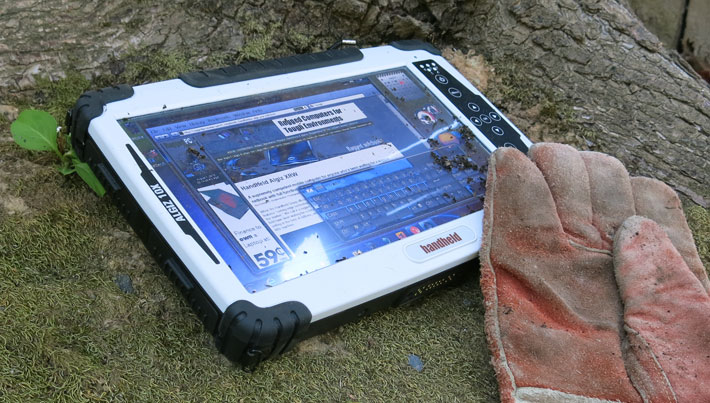
The positioning of the Algiz 10X is quite clear. Handheld made a conscious decision to create a conventional Windows tablet for customers who may be intrigued by all those slender consumer tablets, but who really need a practical, durable tablet to run Windows software on. Capacitive multi-touch quite obviously is the popular choice these days, but it doesn't work with gloves or in the rain, and Handheld's customers often wear gloves and work in the rain.
Likewise, while today's consumer tablets are ever more slender and lightweight, that also makes them fragile and lacking the space for industry standard ports and connectors. Here again, Handheld's customers may admire those sexy consumer tablets, but out there in the field their computing devices must hold up to whatever abuse they may encounter, and they must connect with standard cables and connectors. And sometimes even to devices and peripherals that still use the time-tested RS232 serial interface, and there are still plenty of them. So that's what the Algiz 10X is. That doesn't mean, though, that this Algiz tablet is old-fashioned. Far from it.
The hardware
Below you can see what the Algiz 10X looks like from the front and from all four sides. Note that all ports are sealed with rubber plugs that are attached to the computer with small Philips screws so that they can easily be replaced should they ever break or rip off. The very sturdy corner bumpers, on the other hand, are part of the housing, attached during an injection molding process.
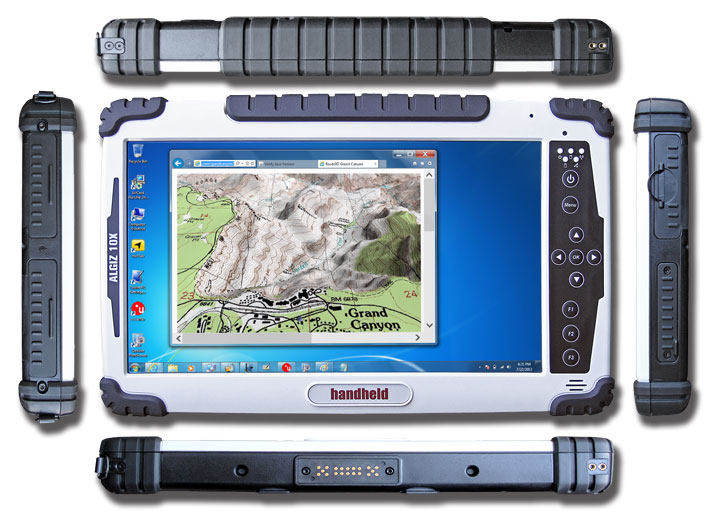
Taking a closer look at the sides of the unit which include most of the built-in connectivity (see details in the pictures below, with some of the protective rubber plugs opened and photoshopped out of the pictures):
- Along the left side (top picture) are power, a standard VGA video port, a standard USB 2.0 port, and a standard legacy DB9 RS232 serial port. There are also two metal loops that can be used with a carry strap.
- Along the right side (bottom picture) is an expansion slot area that contains a SIM Card slot and an SDHC Card slot. Both sit underneath a protective cover that is screwed down. To the right of it is another I/O block with a headphone/microphone jack, a (new as of February 2015) high-speed USB 3.0 port, and an RJ45 Gigabit LAN jack.
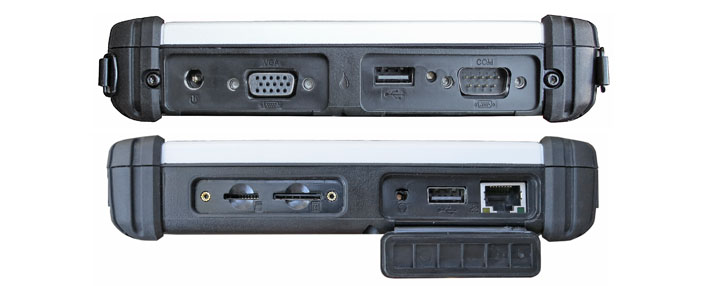
Construction and components
In terms of construction, the Algiz 10X housing consists of two plastic halves, secured together via ten Torx head screws. A tongue-and-groove rubber seal design keeps dust and moisture from penetrating. The front half is off-white, the back side a very dark gray. It's the same colors used in all Handheld brand products.
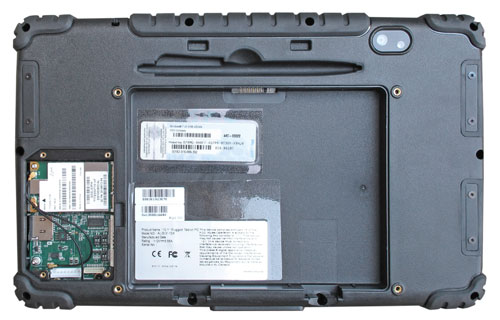 The picture to the right shows the backside of the 10X with the expansion compartment access door and the battery removed. The screw holes around the battery compartment are for vehicle or stationary mounting. The picture to the right shows the backside of the 10X with the expansion compartment access door and the battery removed. The screw holes around the battery compartment are for vehicle or stationary mounting.
The expansion bay compartment in our review unit contained a Sierra Wireless AirPrime MC7354 mini-PCIe card that provides LTE, DC-HSPA+, HSPA+, HSDPA, HSUPA, WCDMA, GSM, GPRS, EDGE, CDMA, and GNSS connectivity. Underneath the card is a SIM card slot. A second mini-PCIe slot is next to it, sitting on top of the unit's externally accessible micro-SD card slot.
The Algiz 10X battery fits flush into a compartment in the back of the tablet. The battery is part of the design and there is no battery compartment cover.
Once the Torx T9 screws holding the two parts of the housing together have been removed, you can carefully lift up the bottom part. This allows you to peruse the sturdy metal frame that is fastened to the front half of the housing. It cradles and secures the LCD assembly. All circuit boards are fastened to the front half as well. The picture below shows what it looks like inside the tablet.
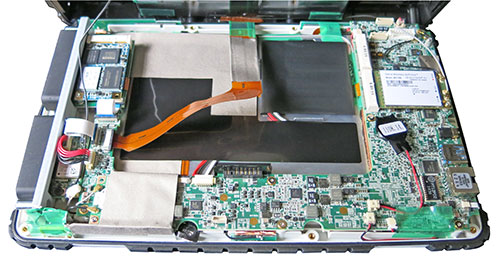 Our Algiz 10X came with a Solid State Disk (see upper left corner). It is a Phison-labeled SSE128GPTC0-S81 mSATA 6GB/s SSD, securely held in place via a small Torx screw. mSATA (which stands for mini-SATA) is a space-saving, lower voltage SATA standard that uses the same 51 x 30 mm form factor as Mini PCIe. The connector is the same as well, with 52 pins, but its data signals talk to the SATA host controller and not the PCIe controller. Our Algiz 10X came with a Solid State Disk (see upper left corner). It is a Phison-labeled SSE128GPTC0-S81 mSATA 6GB/s SSD, securely held in place via a small Torx screw. mSATA (which stands for mini-SATA) is a space-saving, lower voltage SATA standard that uses the same 51 x 30 mm form factor as Mini PCIe. The connector is the same as well, with 52 pins, but its data signals talk to the SATA host controller and not the PCIe controller.
There did not appear to be a user-accessible RAM module slot. Our device came with 4GB of RAM, and that seems the only available configuration.
As far as cooling goes, the Algiz 10X does not have or need a fan; instead, a copper heat spreader plate distributes the heat from the processor to the internal metal LCD frame of the device. It's an elegant thermal solution, but the original 10X did heat up quite a bit under normal operation. That's an issue that seems to have been addressed with the second gen version.
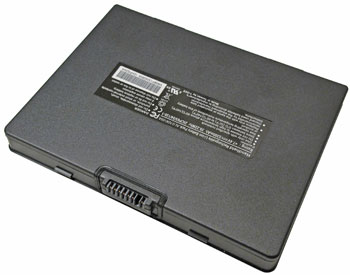 To provide onboard connectivity, Handheld used edge connectors on the motherboard for audio, RJ45 LAN, and USB 3.0. These interface ports are sealed with a single rubber hinged friction plug that has a little metal D-ring on it to pull it open. To provide onboard connectivity, Handheld used edge connectors on the motherboard for audio, RJ45 LAN, and USB 3.0. These interface ports are sealed with a single rubber hinged friction plug that has a little metal D-ring on it to pull it open.
I/O on the other side of the 10X is via two separate I/O modules, one of them provides serial and USB, and the other VGA and power. Both are easily replaceable, which means a) easy repairs should they ever become necessarily, and b) easy device customization.
Sealing of the battery compartment to the interior of the computer is via a rubber seal around the battery connector block. The standard battery itself provides 39.11 watt-hours (7.4Volts, 5,300mAH). It is held in place with two plastic snapping latches. The coverless approach means you can use the optional extended battery without needing a different battery cover.
The Algiz 10X includes an integrated 5-megapixel documentation camera with LED illuminator light. The GPS module is a u-blox6 NEO-6T, using the company's miniature 16.0 x 12.2 x 2.4 mm NEO form factor. The module (see product page) is a 50-channel stand-alone GPS receiver with a hot start time-to-first-fix of under a second. Horizontal positioning accuracy is about 8 feet, and a bit less with SBAS. The module also supports u-blox AssistNow online and offline A-GPS services, passive and active antennas, and it has a time-pulse output that can be used for very precise time measurements.
As part of the 2015 update, Algiz 10X models now come with fast dual-band 802.11ac a/b/g/n WiFi and integrated Bluetooth v4.0, the latest (and more power-efficient) version.
Performance -- good with the initial Atom N2800, but much quicker now with the quad-core "Bay Trail" Celeron N2930
The Algiz 10X was initially powered by what at the time of its design arguably was Intel's best available Atom processor. The 1.86GHz N2800 provided the kind of performance Atoms should have provided all along, but initially couldn't because that would have meant they'd have been faster than Intel's mobile Core 2 Duo offerings at the time.
Core Duos are long gone now, and with Intel's Core CPUs ascending into the speed and feature stratosphere, the company's Atom architecture was given a very major performance overhaul in the form of "Bay Trail." Bay Trail consists of a lineup of vastly improved CPUs that are powerful enough to not only be sold under the Atom brand, but also the Celeron and Pentium brands. The platform represents the first true architectural update to Atom since its introduction in 2008.
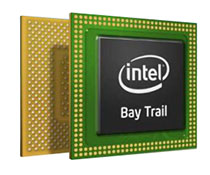 Bay Trail processors use up to four cores and, for the first time, an Intel Atom microprocessor architecture is paired with Intel's own HD graphics. The graphics cores integrated into Bay Trail systems are of the same HD 4000 architecture and variety as those used in Intel's 3rd generation "Ivy Bridge" processors, albeit with fewer execution units (four instead of several times that number) and lower clock speeds. There's also turbo boost (called "burst frequency") in some processors, and a number of clever power-saving features from Core processors are there as well. Bay Trail processors use up to four cores and, for the first time, an Intel Atom microprocessor architecture is paired with Intel's own HD graphics. The graphics cores integrated into Bay Trail systems are of the same HD 4000 architecture and variety as those used in Intel's 3rd generation "Ivy Bridge" processors, albeit with fewer execution units (four instead of several times that number) and lower clock speeds. There's also turbo boost (called "burst frequency") in some processors, and a number of clever power-saving features from Core processors are there as well.
The processor Handheld chose to give the 10X as a replacement for the venerable Atom N2800 is the quad-core Celeron N2930, a system-on-chip solution that runs at 1.83GHz, has a burst frequency of 2.16GHz, supports fast but efficient DDR3L RAM, and yet still has a Thermal Design Power of just 7.5 watts.
How quick is the updated Algiz 10X, and what kind of a speed improvement, both overall and graphics, is it over the original version?
To give you an idea of the relative performance of the new and original Handheld Algiz 10X as well as Handheld's two other Algiz brand products, we used our two standard benchmark suites (Passmark Software's PerformanceTest and CrystalMark). Here are the results:
|
Handheld Algiz 10X Benchmarks and Comparisons (PassMark 6.1, 32-bit version)
|
|
PERFORMANCE COMPARISON
|
Algiz 10x (2015)
|
Algiz 10x (original)
|
Algiz XRW
|
Algiz 7 (2013)
|
|
|

|

|

|

|
|
Processor Type:
|
Intel Celeron
|
Intel Atom
|
Intel Atom
|
Intel Atom
|
|
Processor Model
|
N2930
|
N2800
|
N2600
|
N2600
|
|
CPU cores/threads
|
4/4
|
2/2
|
2/2
|
2/2
|
|
CPU base speed
|
1.83GHz
|
1.86GHz
|
1.60GHz
|
1.60GHz
|
|
CPU burst speed
|
2.16GHz
|
NA
|
NA
|
NA
|
|
Thermal Design Power (TDP)
|
7.5 watts
|
6.5 watts
|
3.5 watts
|
3.5 watts
|
|
Disk
|
256GB SATA SSD
|
128GB SATA SSD
|
128GB SATA SSD
|
128GB SATA SSD
|
|
CPU Mark
|
2,196.3
|
538.4
|
469.6
|
461.8
|
|
2D Graphics Mark
|
158.0
|
38.8
|
NA
|
NA
|
|
Memory Mark
|
452.9
|
264.2
|
221.8
|
217.6
|
|
Disk Mark
|
2,387.9
|
1,732.8
|
1,631.4
|
1,654.5
|
|
3D Graphics Mark
|
136.9
|
80.3
|
55.5
|
64.9
|
|
Overall PassMark
|
1,190.7
|
554.5
|
499.7
|
502.5
|
|
CrystalMark ALU
|
28,377
|
12,191
|
9.941
|
10,528
|
|
CrystalMark FPU
|
24,109
|
9,374
|
7,939
|
7,681
|
|
CrystalMark MEM
|
19,952
|
8,654
|
7,407
|
7,274
|
|
CrystalMark HDD
|
36,318
|
27,789
|
26,656
|
26,860
|
|
CrystalMark GDI
|
5,262
|
1,683
|
1,366
|
1,451
|
|
CrystalMark D2D
|
3,870
|
689
|
507
|
798
|
|
CrystalMark OGL
|
3,580
|
8,841
|
6,192
|
7,404
|
|
Overall CrystalMark
|
121,468
|
69,221
|
60,008
|
61,996
|
When we first benchmarked the original Algiz 10X, we considered its speed quite impressive. Handheld had been one of the few to use the more potent Intel Atom N2800 chip instead of the standard N2600 version, and that gave the first Algiz 10X an noticeable edge over competitors using the slower chip, especially in graphics where the N2800 processor graphics ran at a 60% higher clock speed.
But that was then (2013) and this is now. The new Algiz 10X is twice as fast as the original. Each of the cores of the N2930 chip is more than twice as powerful as the cores in the older N2800, and there are now four cores instead of just two. Memory, graphics, disk are all faster. One exception is OGL graphics where the N2600/N2800 scored almost inexplicably high results. Overall, though, the Algiz 10X tablet is now a very good performer, as fast, or faster, than full-size, Intel Core-based rugged laptops were just a few short years ago.
Battery and (much improved) battery life
Manufacturers usually resort to Atom processors primarily for reasons of cost, low power draw and less complexity. Processor and chipset, though, are only part of the full package, and overall power draw depends on not only the power efficiency of all components, but also design, settings, workload, and how well power conservation measures are implemented.
As is, the standard battery of the Algiz 10X packs only about 38.5 watt-hours. That's less than a 3rd or 4th gen iPad, and also about 20 watt-hours less than the Algiz XRW rugged netbook. That is not very much for a powerful Windows tablet with a bright display. Will it do?
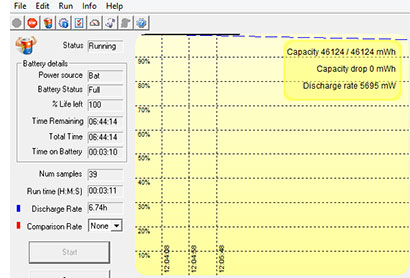 We used our battery benchmark software, Passmark's BatteryMon, to examine power draw of the Algiz 10X. With Windows Power Options set to to Power Saver and backlight brightness almost all the way down, power draw was a low 5.6 watts, good for almost seven hours of theoretical operation. That's 1.2 watts lower than the old machine! We used our battery benchmark software, Passmark's BatteryMon, to examine power draw of the Algiz 10X. With Windows Power Options set to to Power Saver and backlight brightness almost all the way down, power draw was a low 5.6 watts, good for almost seven hours of theoretical operation. That's 1.2 watts lower than the old machine!
With Windows power settings switched to "Balanced," and using the about 40% default screen brightness that went with it, power draw rose to 6.6 watts, good for almost six hours, and 2.4 watts lower than the predecessor.
What about maximum draw? With Windows Power settings set to "Performance" and backlight brightness all the way up, draw jumped to 9.3 watts, still good for over four hours, and a whopping 5.2 watts less than the first generation machine. Playing full 1080p HD video at full brightness, full power, and all options on, we saw about 10.5 watts, a full seven watts less than the older version, and that means still over 3.5 hours on a full charge.
While we considered the power draws of the original Algiz 10X a bit higher than expected (likely a price the unit paid for using the faster Atom N2800 chip which had a TDP of 6.5 watts compared to just 3.5 watts for the 1.6GHz N2600), the new N2930-based model fixes that quite impressively. It's obvious that the new processor inside the Algiz 10X performs even complex operations without breaking a sweat, thus using significantly less power. What it boils down to is that the new version is not only twice as fast, it has better battery life to boot.
It also means that the optional 77 watt-hour extended battery is a) no longer an almost mandatory accessory, and b) that it will no result in exceptional battery life.
Keypad and utilities
As a tablet, the Algiz 10X does not have a physical keyboard or keypad. Instead, data is entered via on-screen keyboard and numeric keypad.
There is, however, what Handheld calls the OSD Control Keypad (see below) along the right side of the display. It includes power, a navigation diamond with an OK key in the middle, a Menu button, and five indicator lights for power, battery status of each of the two batteries, disk activity and wireless radio status. They are small and easy to see, without being too bright. The Menu button brings up separate on-screen control panels for brightness, volume, battery status, and on/off controls for Wi-Fi, Bluetooth, WWAN, GPS, camera, and installed antennae.

The F1, F2, and F3 function keys on the OSD Control Keypad can be programmed via the Hot TAB utility (Windows 7 version shown below; Windows 8 version uses "charm" style). The utility can be used to quickly call up the onscreen keyboard, start the camera app, or perform a screen rotation (in 90 degree increments). It is also used to assign functions, utilities or apps to the three function buttons. Each button can perform two functions via short or long push.

The Hot TAB utility can also be used to quickly switch the Algiz 10X between four different power settings (Power Saving, Office/Document, High Performance, and Extreme Performance).
One thing we do recommend to Windows 7 users is optimizing the Algiz 10X display for tablet operation. In the Windows Control Panel, use the Personalization>Windows Color>Advanced Appearance Settings to re-size check boxes, scrollers, text, and various other Windows interface elements for best possible operation with a stylus. That's important as the rather high resolution of the Algiz 10X display makes some of those elements too small for easy use. In fact, we'd recommend Handheld include an already optimized configuration. Help on how to do this on Windows 8 can be found here.
Display, now with great viewing angles from all sides
Screen size in mobile devices is a curious thing. With cellphones, first the phones and screens couldn't be small enough, and now they can't be large enough. Notebook screens got larger and larger and larger until they reached 17 inches, then backed off some. For years, most tablets had 8.4-inch screens, with some venturing up to 10 inches and even 12. Then the iPad came and pretty much made the 10-inch screen the tablet default, but all of a sudden smaller 7-inch screens are popular. You just never know.
Except that sometimes you do know what makes the most sense. And that's especially true with Windows tablets, because Windows just wasn't designed for tiny screens. And not only are there times when you simply do need a larger display for certain tasks, there are also times when applications do require more pixels than what's available on traditional SVGA and XGA devices. Here, the Algiz 10X screen's higher 1,366 x 768 pixel resolution comes in handy, as does Handheld's MaxView display technology.
How well does it all work in practice? We initially thought the screen of the new model was the same as that of the old version as there was no mention of any change in Handheld's materials. However, it quickly became clear that something had changed. The display of the original Algiz 10X was quite good, but did suffer from a narrow vertical viewing angle, resulting in quite a bit of color shifting and aberrations. In our review, we wished that Handheld had used the near perfect display of identical size and proportions that comes with their rugged compact Algiz XRW notebook.
As is, the new screen no longer has the vertical viewing angle problem, and quite likely is the same display used in the XRW. Users will certainly appreciate that.
To show how it all works in the new Algiz 10X we took it outside on a sonny California spring and placed it side-by-side with the same Microsoft Surface RT tablet we had used in the original Algiz 10X comparison. Regretfully for Microsoft, the Surface RT wasn't exactly successful due to the wing-clipped RT version of Windows, even though its hardware was actually quite good, and the display was excellent for indoor use.
So, the first image below shows the two systems outdoors in partial shade. According to the specs, the Algiz 10X backlight is a strong 600 nits, though it doesn't look visibly brighter than the also quite bright Surface RT display. That's primarily because the RT has a high-gloss display with capacitive touch, whereas the Algiz 10X display surface is significantly less glossy and has that resistive touch screen overlay.
Outdoor reflections, however, are hard to handle for even the best displays, and though the 10X display surface isn't nearly as glossy as the Microsoft tablet's, there are some diffused reflections. It does well, though, compared to the Surface RT display, which becomes a veritable mirror.
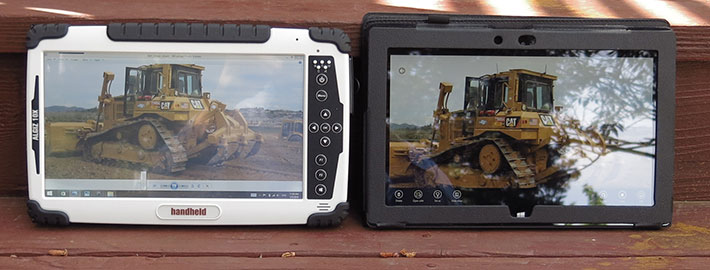
In the second picture below, the computers are placed in shaded area mostly away from the sun. Here, the 10X display looks noticeably clearer and totally reflection-free, and Handheld's MaxView technology clearly does its thing. The Surface RT display is just too glossy to keep reflections at bay.
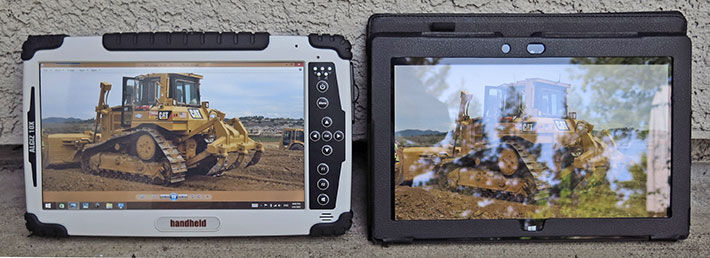
In the third picture below, the systems are indoors. Here, you can see that despite the resistive overlay, the ALgiz 10X display looks bright and very good, even compared to the glossy display of the Surface RT.
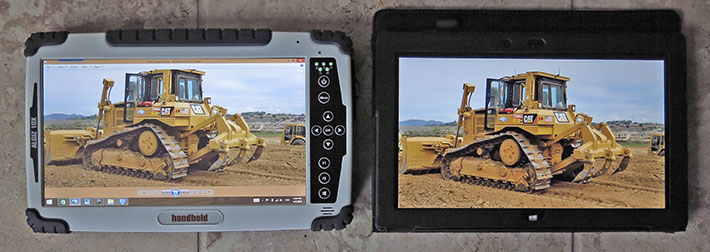
Overall, Handheld's MaxView display treatment works quite well, though the resistive touch screen does mute the image quite a bit under certain usage conditions. We blame the resistive touch overlay here, as the Algiz XRW which (we believe) uses the same screen but doesn't have the digitizer overlay doesn't mute nearly as much.
Superior ruggedness
The Handheld Group describes the Algiz 10X as an ultra-rugged device designed for extreme field performance. According to its specs, the Algiz 10x can handle a very wide operating temperature range from -4 to 140 degrees Fahrenheit (-20 to 60 Celsius). It carries IP65 sealing where the "6" means the computer is totally protected from dust, and the "5" that it is protected against low pressure jets of water from all directions. The Algiz 10X also passed the MIL-STD-810G 516.6. Procedure IV test of 26 drops from a height of four feet to concrete. What does all this mean?
As far as operating temperature goes, the device can be used in most environments where someone would be expected to work with a computer. The folks at the Handheld Group's native Sweden know a thing or two about ice and snow and working in the cold, so we're sure they have low temperature suitability covered, and not having rotating media onboard sure helps.
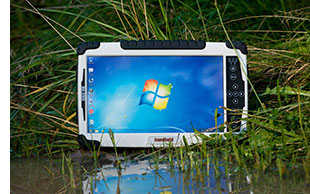 Not having a hard disk also helps make the unit immune to drops from four feet, which is about the height it may fall while being used in a standing position. Here, the Algiz 10X's modest weight and the protective corner bumpers provide excellent shock resistance. Not having a hard disk also helps make the unit immune to drops from four feet, which is about the height it may fall while being used in a standing position. Here, the Algiz 10X's modest weight and the protective corner bumpers provide excellent shock resistance.
IP65 is decent sealing, but it's not IP67 which is increasingly expected in rugged outdoor gear, thanks to a growing number of IP67-rated active lifestyle consumer smartphones. So why not IP67, which protects a device even against immersion into water to a depth of about three feet? Probably because it's much more involved to seal a device with multiple standard-size ports and a quick-release battery to IP67 standard. So IP65 is okay, but we are a little concerned about potential leaks to the interior should the somewhat hard to manipulate plastic plugs not be seated properly.
Vibration resistance was tested as described in MIL-STD-810G, Method 514.6, Procedures I & II, for general vibration in a fixed mounting and a loose cargo test, but there is no detailed description.
The Algiz 10X can handle operating altitudes up to 15,000 feet, and was tested according to MIL-STD-810G, Method 507.5 for humidity resistance.
While some customers will probably want to see actual lab reports with more specific detail, the overall impression of the Algiz 10X is that it's indeed a very rugged device that will likely be able to handle a good deal of abuse.
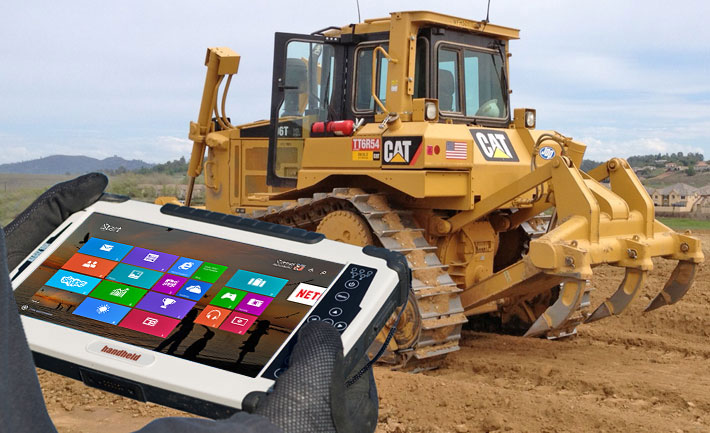
Summary: Handheld Algiz 10X
Overall, the Algiz 10X tablet carries on on Handheld's tradition of offering interesting, versatile mobile computers covering every conceivable part of Handheld's target markets. This tablet is for anyone who needs both legacy and state-of-the-art Windows functionality out there in the field, and enough screen real estate for complex applications.
 Thanks to the switch to a much more powerful processor, the updated second generation Algiz 10X offers substantially more computing power than the original, in the order of 2X. And despite the significant boost in speed, the updated model actually offers longer battery life. Thanks to the switch to a much more powerful processor, the updated second generation Algiz 10X offers substantially more computing power than the original, in the order of 2X. And despite the significant boost in speed, the updated model actually offers longer battery life.
The 10.1-inch daylight-viewable wide-format resistive touch screen display with its 1366 x 768 pixel resolution is well suited even for information-intensive applications and websites. The display has been updated as well, and now has excellent viewing angles in all directions.
The Algiz 10X is rugged enough to be used in almost any environment, and its integrated bumpers protect against dents and scratches. It feels very solid and reliable, but do make sure the protective rubber plugs are always securely in place.
The unit provides very good onboard communication both for wired connections (USB, serial, LAN, audio, video) as well as wireless (WiFi, WWAN, Bluetooth, GPS). The second gen update brings USB 3.0 and much quicker wireless performance.
Like most specialized vertical market computing equipment, the cost is substantially higher than for consumer equivalents, but in terms of functionality on the job and total cost of ownership, the Algiz 10X is reasonably priced.
In summary, the Handheld Algiz 10X addresses the needs of anyone who's been looking for a tough, rugged Windows tablet for demanding work even under the most demanding environmental conditions, and one with a large enough display to comfortably work on. And now it's even faster. -- Conrad H. Blickenstorfer, April 2015
Handheld Algiz 10X Specs (incl. 2015, 2016 updates):
| Status |
Added 10/2012, updated 05/2013, full review 08/2013, updated April 2015, September 2016
|
| Type |
Ultra-rugged tablet computer
|
| Processor |
Quad-core Intel Celeron N2930 with 2MB L2 cache |
| Processor speed |
1.83GHz base frequency, 2.16GHz maximum burst frequency |
| OS |
Windows 8.1 Pro, Windows 7 downgrade available; as of September 2016: Windows 10 Enterprise LTSB (64-bit) |
| Chipset Controller |
Intel integrated |
| Graphics |
Intel HD Graphics |
| Memory |
4GB DDR3 |
| Display type |
Sunlight-readable 10.1-inch "MaxView" TFT with 600 nits LED backlight and ambient light sensor |
| Display resolution |
WXGA 1,366 x 768 pixel (720p); September 2016 upgrade: 1,920 x 1,200 pixel (1080p) |
| Digitizer/Pens |
4-wire resistive single touch touchscreen; September 2016 upgrade: 10-point projected capacitive multi-touch with optional active capacitive pen
|
| Keyboard |
On-screen QWERTY soft kbd, power, menu key, 3 programmable, navigation |
| Storage |
128GB SSD mSATA 6GB/s |
| Expansion |
1 microSDXC |
| Housing |
Plastic with protective rubber bumpers |
| Operating temperature |
-4 to 140 degrees Fahrenheit (-20 to 60 degrees centigrade) |
| Vibration/Drops |
MIL-STD-810G, Method 514.6 Procedures I & II, General minimum integrity and the more rigorous loose cargo test
|
| Enclosure Class |
IP65, MIL-STD-810G |
| Hazardous materials |
unknown |
| Size |
10.8 x 6.7 x 1.2 inches (275 x 171 x 32 mm) |
| Weight |
3.1 pounds (1.4 kg) as tested
|
| Power |
Hot-swappable 7.4V, 5,300mAH 38.5 watt-hour Li-Ion battery pack; optional 77 watt-hour extended battery
|
| Camera |
5-megapixel Camera + LED flash
|
| Communication |
Dual-band 802.11ac WiFi , Bluetooth v4.0, integrated u-blox GPS NEO-6T, optional WWAN GSM/GPRS, HSPA+, LTE; September 2016 upgrade: integrated u-blox GPS NEO-M8N
|
| Interface |
1 x USB 2.0, 1 x USB 3.0, 1 x DB9 RS-232, 1 x gigabit RJ45, 1 x VGA, audio in/out, docking connector, 1 speaker
|
| Price |
Starting at US$2,849
|
| Spec sheet |
 Algiz 10X spec sheet (2016) Algiz 10X spec sheet (2016) |
| Product manual |
 Algiz 10X manual Algiz 10X manual |
| Web page |
Handheld Group Algiz 10X web page (2016) |
| Contact |
Handheld Group AB
Kinnegatan 17A
531 33 Lidköping, Sweden
Tel: +46 (0) 510 54 71 70
Fax: +46 (0) 510 282 05
Web: www.handheldgroup.com
Email: info at handheldgroup.com
|
HHCS Handheld USA Inc.
33870 SE Eastgate Circle
Corvallis, OR 97333, USA
Tel: (541) 752-0313
Fax: (541) 752-0338
Web: www.handheld-us.com
Email: info at handheld-us.com
|
|
(copyright 2016 RuggedPCReview.com)
|





 Also of note is the latest version of Handheld's MaxView display technology that uses a combination of optical treatments to make their displays remarkably vibrant and readable under virtually all viewing conditions. Handheld uses a special bonding process to "melt" LCD, anti-glare filter and touchscreen together, minimizing reflections and making the screen stronger. Among the many benefits of the MaxView technology are increased contrast ratio, elimination of the "parallax" effect (i.e., where the pen tip position seemed to shift due to the thickness of the glass), extra durability and impact absorption, and no danger of condensation between layers.
Also of note is the latest version of Handheld's MaxView display technology that uses a combination of optical treatments to make their displays remarkably vibrant and readable under virtually all viewing conditions. Handheld uses a special bonding process to "melt" LCD, anti-glare filter and touchscreen together, minimizing reflections and making the screen stronger. Among the many benefits of the MaxView technology are increased contrast ratio, elimination of the "parallax" effect (i.e., where the pen tip position seemed to shift due to the thickness of the glass), extra durability and impact absorption, and no danger of condensation between layers.



 The picture to the right shows the backside of the 10X with the expansion compartment access door and the battery removed. The screw holes around the battery compartment are for vehicle or stationary mounting.
The picture to the right shows the backside of the 10X with the expansion compartment access door and the battery removed. The screw holes around the battery compartment are for vehicle or stationary mounting.
 Our Algiz 10X came with a Solid State Disk (see upper left corner). It is a Phison-labeled SSE128GPTC0-S81 mSATA 6GB/s SSD, securely held in place via a small Torx screw. mSATA (which stands for mini-SATA) is a space-saving, lower voltage SATA standard that uses the same 51 x 30 mm form factor as Mini PCIe. The connector is the same as well, with 52 pins, but its data signals talk to the SATA host controller and not the PCIe controller.
Our Algiz 10X came with a Solid State Disk (see upper left corner). It is a Phison-labeled SSE128GPTC0-S81 mSATA 6GB/s SSD, securely held in place via a small Torx screw. mSATA (which stands for mini-SATA) is a space-saving, lower voltage SATA standard that uses the same 51 x 30 mm form factor as Mini PCIe. The connector is the same as well, with 52 pins, but its data signals talk to the SATA host controller and not the PCIe controller.
 To provide onboard connectivity, Handheld used edge connectors on the motherboard for audio, RJ45 LAN, and USB 3.0. These interface ports are sealed with a single rubber hinged friction plug that has a little metal D-ring on it to pull it open.
To provide onboard connectivity, Handheld used edge connectors on the motherboard for audio, RJ45 LAN, and USB 3.0. These interface ports are sealed with a single rubber hinged friction plug that has a little metal D-ring on it to pull it open.
 Bay Trail processors use up to four cores and, for the first time, an Intel Atom microprocessor architecture is paired with Intel's own HD graphics. The graphics cores integrated into Bay Trail systems are of the same HD 4000 architecture and variety as those used in Intel's 3rd generation "Ivy Bridge" processors, albeit with fewer execution units (four instead of several times that number) and lower clock speeds. There's also turbo boost (called "burst frequency") in some processors, and a number of clever power-saving features from Core processors are there as well.
Bay Trail processors use up to four cores and, for the first time, an Intel Atom microprocessor architecture is paired with Intel's own HD graphics. The graphics cores integrated into Bay Trail systems are of the same HD 4000 architecture and variety as those used in Intel's 3rd generation "Ivy Bridge" processors, albeit with fewer execution units (four instead of several times that number) and lower clock speeds. There's also turbo boost (called "burst frequency") in some processors, and a number of clever power-saving features from Core processors are there as well.



 We used our battery benchmark software, Passmark's BatteryMon, to examine power draw of the Algiz 10X. With Windows Power Options set to to Power Saver and backlight brightness almost all the way down, power draw was a low 5.6 watts, good for almost seven hours of theoretical operation. That's 1.2 watts lower than the old machine!
We used our battery benchmark software, Passmark's BatteryMon, to examine power draw of the Algiz 10X. With Windows Power Options set to to Power Saver and backlight brightness almost all the way down, power draw was a low 5.6 watts, good for almost seven hours of theoretical operation. That's 1.2 watts lower than the old machine!





 Not having a hard disk also helps make the unit immune to drops from four feet, which is about the height it may fall while being used in a standing position. Here, the Algiz 10X's modest weight and the protective corner bumpers provide excellent shock resistance.
Not having a hard disk also helps make the unit immune to drops from four feet, which is about the height it may fall while being used in a standing position. Here, the Algiz 10X's modest weight and the protective corner bumpers provide excellent shock resistance.

 Thanks to the switch to a much more powerful processor, the updated second generation Algiz 10X offers substantially more computing power than the original, in the order of 2X. And despite the significant boost in speed, the updated model actually offers longer battery life.
Thanks to the switch to a much more powerful processor, the updated second generation Algiz 10X offers substantially more computing power than the original, in the order of 2X. And despite the significant boost in speed, the updated model actually offers longer battery life.
